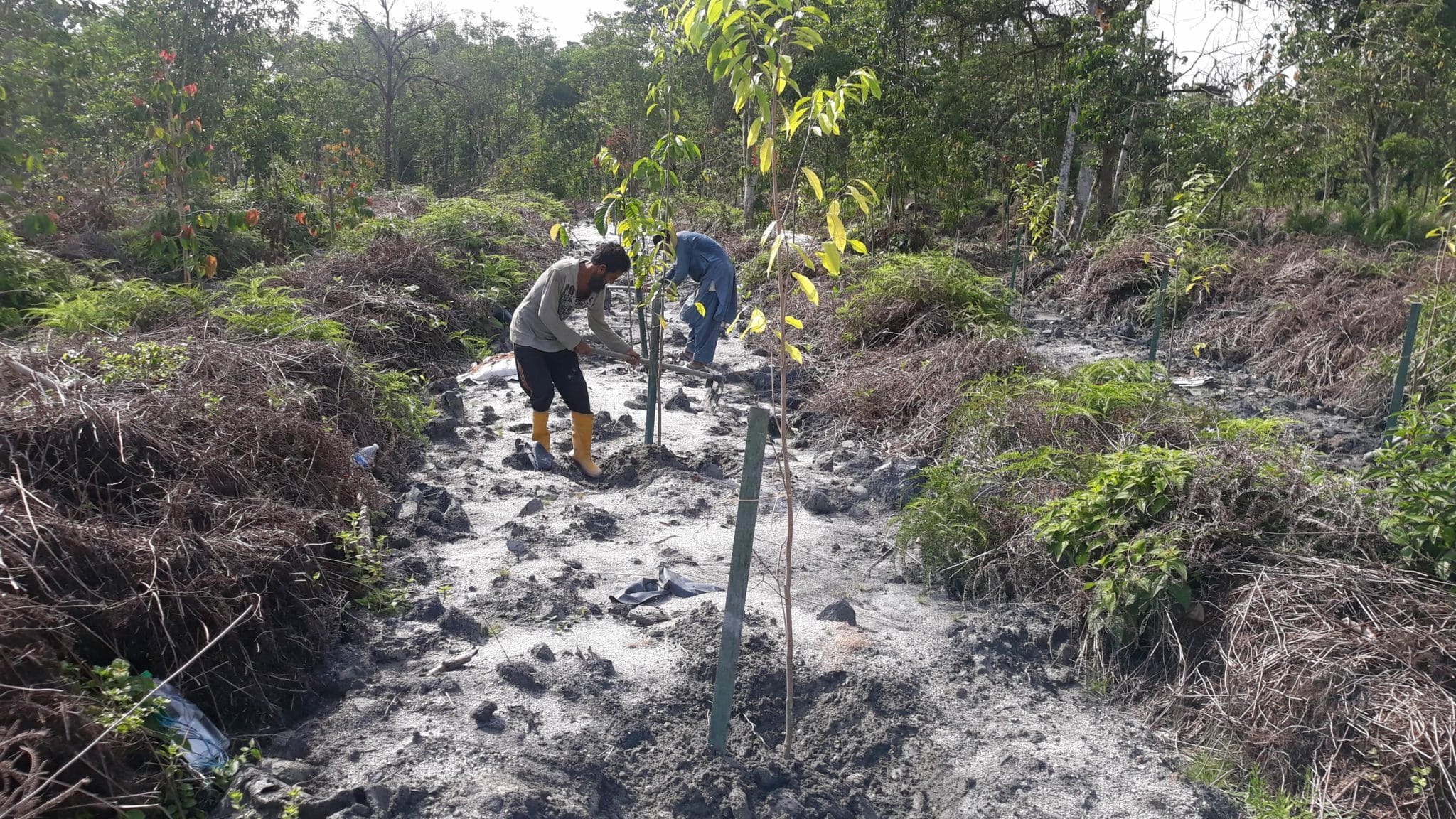Introduction
The Sixth Assessment Report of the Intergovernmental Panel on Climate Change (IPCC) has highlighted that climate change is impacting all regions across the globe — increasing temperatures, rising sea levels, prolonged fire seasons of higher intensity, increasing occurrences of warmer days, (IPCC, 2022).
The restoration of ecosystems gained global attention when the United Nations General Assembly proclaimed the United Nations Decade on Ecosystem Restoration 2021-2030 (UN Decade), which calls for the protection and revival of ecosystems all around the world for the benefit of people and nature. Under the leadership of the United Nations Environment Programme (UNEP) and the Food and Agriculture Organization of the United Nations (UN FAO), fifty voluntary restoration initiatives have already started on six continents contributing to the UN Decade to date. Restoration activities under these initiatives mainly involve planting trees and enhancing the natural regeneration abilities of forests to recover ecosystem conditions (UN Decade, 2022). The importance of ecosystem restoration has also been included in CBD’s “First Draft of the Post-2020 Global Biodiversity Framework” as one of the key targets “Use ecosystem-based approaches to contribute to mitigation and adaptation to climate change, contributing at least 10 GtCO2e per year to mitigation; and ensure that all mitigation and adaptation efforts avoid negative impacts on biodiversity”.
When looking at ecosystem restoration activities, it is obvious that forests play a critical role in restoring ecosystems through nature itself—one of the best examples of nature-based solutions (NbS) (WWF, 2022). Speaking of NbS, two questions come into our mind: What are NbS? What are NbS actions? The International Union for Conservation of Nature (IUCN) defines NbS as “actions to protect, sustainably manage and restore natural and modified ecosystems in ways that address societal challenges effectively and adaptively, to provide both human well-being and biodiversity benefits”. The University of Oxford specified that “protection, restoration, sustainable management of aquatic systems and working lands, creation of novel ecosystems” are actions involve in NbS (Oxford, 2022).
Important Findings
There are many benefits that forests could provide to humans and the planet. From a climate change mitigation point of view, forests remove carbon from the atmosphere and absorb carbon emissions caused by human activity. Recently, the important role of forests in contributing much sustainable development, strengthening the political will, commitments to reduce deforestation, and enhancing restoration of forest ecosystems has been highlighted in “The State of the World’s Forests 2020”.
Global Forest Watch pointed out the vital roles of forests in biodiversity and climate as “Forest can provide 30% of the solution to keeping global warming below two degrees Celsius”, and “Forests are home to 80% of terrestrial species”. Protecting forest habitats is key to conserving our planet’s biodiversity and effectively mitigating climate change (Watch, 2022).
Global assessment reports such as CBD’s “Global Biodiversity Outlook 5 (GBO-5)” and IPBES’s “Global Assessment Report on Biodiversity and Ecosystem Services” warned that biodiversity and its services will continue to decline due to multiple human impacts and future environmental objectives may only achieve through sustainable and nature-friendly approaches. IPBES estimated that safeguarded nature-based solutions could support meeting global goals for climate change, keeping climate warming below 2°C, and biodiversity (IPBES, 2019). GBO-5 precisely highlighted that “around one-third of the net reductions in greenhouse gas emissions required to meet the Paris Agreement’s goals could come from “nature-based solutions”. GBO-5 also urged to take transformative actions to achieve the 2050 Vision for Biodiversity including “Sustainable Climate Action”, which recognizes the role of biodiversity and the positive impacts of nature-based solutions. Nature-based solutions such as conservation and restoration of ecosystems could be important to climate change adaptation (CBD, 2020).
According to the Nature-based Solutions for Climate Change Mitigation report by UNEP and IUCN, it is more cost-effective and quick to reduce emissions by stopping the loss or deterioration of natural ecosystems than it is to add carbon to harmed ecosystems. This is in line with a hierarchy-based strategy to mitigating impacts on biodiversity and ecosystem services, according to which damages should first be avoided, then minimized when that is not possible, and last restored when they do occur. If effects persist, they should be balanced out by similar action taken elsewhere. All other things being equal, protecting ecosystems from conversion should be prioritized above addressing the causes of ecosystem degradation, which is preceded by the restoration of ecosystems (UNEP & IUCN, 2021).
Research has shown that NbS can provide powerful support in reducing our planet’s temperature in long term and a vast amount of carbon must remove from the atmosphere. Forest plays a critical part in keeping carbon and by increasing, forest cover biodiversity will be protected, water resources will be managed, create jobs for the people, and notably support the United Nations Sustainable Development Goals 1, 6, 11, 13, and 15. Recognizing the significant importance of forests, scientists also called on the restoration community, forestry experts, and policymakers to prioritize the regeneration of natural forests with a focus on the restoration of disturbed lands and enhancing the protection of existing forests (Lewis, 2019).
Stories from the Region
Nature-based solutions are simple approaches that each and everyone on earth could directly participate in solving environmental problems such as climate change and biodiversity loss. Around the world, several nature-based solutions have already been initiated as studied by non-governmental organizations and universities. One example from the voluntary implementer of the UN Decade on Ecosystem Restoration is “Living collection of rare plants patches forests in Malaysia” at 500 ha high conservation value forest, Amanjaya Forest Reserve situated in the Hulu Perak District, Northern Region of Perak, Malaysia. The initiative was started in 2013 and aimed to restore and reconnect the fragmented forests across Malaysia. Through the initiative, seeds from rare, endangered, and threatened plant species were collected, assisted to germinate, and reintroduced into their native habitats. The initiative is still ongoing and working on a seedling development program with indigenous communities to empower them with the technical knowledge on forest management including capacity building of local communities in key plant species identification, seed collection, and germination in communal nurseries. Plants germinated by communities will be bought and used in the initiative’s restoration works (TRLC, 2022).
As a Union-wide effort on NbS, IUCN is working on different NbS themes including business and biodiversity, ecosystem management, forests, governance and rights, marine, urban, and water to support decision-makers and investors with site-based examples. IUCN’s forest sector NbS focuses mainly on Forest Landscape Restoration (FLR) and REDD+, which restore the ecological functionality of forests, protect biodiversity, mitigate climate change and enhance human well-being for a long time (IUCN, 2022). IUCN is implementing an NbS through the ADAPT, a three-year project (till October 2022) that aims to increase the resilience of ecosystems and human communities to climate change and disaster risks in the Western Balkans, through the application of NbS approaches.
AFoCO, as an intergovernmental organization working in the forest sector, has been carrying out programs and activities targeted at establishing customized restoration and reforestation models in its member countries as well as regular training courses to build the capacities of forest policymakers and practitioners in the region. In 2021 AFoCO joined hands with the International Tropical Timber Organization (ITTO) to organize a workshop on FLR to provide participants with a comprehensive understanding of the six FLR principles and associated guiding elements that form the foundation of the new ITTO Guidelines on Forest Landscape Restoration in the Tropics. The workshop also aimed at promoting the effective participation of local communities and stakeholders in community-based restoration activities while ensuring sustainable livelihoods. (The outcomes of the workshop can be found in Policy Brief No. 1 and the accompanying Training Reports.) Most recently, AFoCO has joined the global movement #GenerationRestoration by becoming a Supporting Partner of the UN Decade.
University of Oxford’s “Nature-based Solutions Initiative” recorded 110 cases implemented in 23 ecosystem types from all over the world. One of the examples of positive action is the “Regreening Kenya Project” which aimed to restore over 150,000 ha of degraded land into restoration by 2022 and improve the livelihoods of 50,000 smallholders. This project is part of “Regreening Africa” and has had great success in restoring degraded land and providing benefits to the local people (Oxford, 2022).

Lessons Learned & the Way Forward
Recently, world leaders and global organizations have increased their commitment to integrating NbS into national policies, plans, and targets based on expert analyses and evidence from practical fieldwork. Despite its multiple benefits, there are still ongoing debates about the effectiveness of NbS, especially on its standards and safeguards to avoid possible harm to people and the environment. In certain cases, NbS may lead to bad impacts on the environment and people, for example restoring forest land using one species could destroy the diverseness of the biodiversity and implementing restoration activities in indigenous areas without the consent of locals, as warned by the findings from the environment, development, and local community organizations (Xiaoting Hou-Jones, 2021). In order to optimize nature’s contributions, we must employ systematic and sustainable nature-based approaches which ensure a positive impact on the environment, speed up the long-term involvement of multiple stakeholders and fulfill the global commitments for now and future efforts.
References
- CBD. (2020). Global Biodiversity Outlook 5. CBD.
- IPBES. (2019). Global Assessment Report on Biodiversity and Ecosystem Services. IPBES.
- IUCN. (2022, March 10). Nature-Based Solutions. Retrieved from International Union for Conservation of Nature: https://www.iucn.org/theme/nature-based-solutions/about
- Oxford, U. o. (2022, March 24). Nature-based solutions initiative. Retrieved from University of Oxford: https://www.naturebasedsolutionsinitiative.org/what-are-nature-based-solutions/
- Simon L.Lewis, C. E. (2019). Restoring natural forests is the best way to remove atmospheric carbon. Nature.
- TRLC. (2022, March 29). TRLC Banun. Retrieved from Tropical Rainforest Conservation and Research Center: https://www.trcrc.org/trlc
- UN Decade. (2022, March 10). Restoration Implementers. Retrieved from United Nationa Decade on Ecosystem Restoration 2021-2030: https://implementers.decadeonrestoration.org/implementers
- United Nations Environment Programme and International Union for Conservation of Nature (2021). Nature-based solutions for climate change mitigation. Nairobi and Gland.
- Watch, G. F. (2022, March 29). Global Forest Watch Topics. Retrieved from Global Forest Watch: https://www.globalforestwatch.org/topics/climate/#intro
- WWF. (2022, March 29). Stories/What are nature-based solutions and how can they help us address the climate crisis. Retrieved from WWF: https://www.worldwildlife.org/stories/what-are-nature-based-solutions-and-how-can-they-help-us-address-the-climate-crisis
- Xiaoting Hou-Jones, D. R. (2021). Nature-based Solutions in Action: Lessons from the Frontline. London: Bond.
Contributed by Khin Nyein San and Kittayaporn Jaiarree, 2022 Fellowship Officials from Myanmar and Thailand

